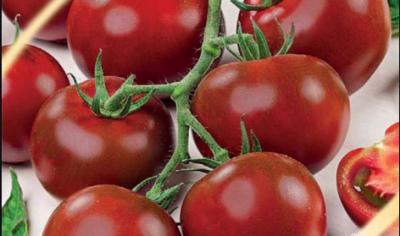
- Authors: Gavrish S.F., Morev V.V., Amcheslavskaya E.V., Degovtsova T.V., Volok O.A., Vasilyeva M.Yu.
- Year of approval: 2015
- Category: grade
- Growth type: indeterminate
- Appointment: fresh consumption
- Ripening period: mid-early
- Growing conditions: for film greenhouses
- Bush size: tall
- Leaves: medium, dark green
- Unripe fruit color: green with a dark green spot at the base
The Black Pearl variety is a new cocktail variety, distinguished by its decorative appearance and excellent taste. Early in terms of ripening, unpretentious to soil and watering, with good immunity. Recommended to be consumed fresh, in salads, suitable for preservation. The variety can be used for landscape design.
Not to be confused with the Black Pearl variety.
Breeding history
The variety was created in 2014 by Russian breeders S.F. Gavrish, V.V. Morev., E.V. Amcheslavskaya, T.V. Degovtsova, O. A. Volok, M. Yu. Vasilieva. Included in the State Register in 2015.
Description of the variety
The bushes are tall, reaching a height of 1.5 meters, the stem is thick and durable, the foliage is medium, the leaf is small, dark green. Growth type is indeterminate. The inflorescence is intermediate. The first inflorescence appears after 8-9 leaves, then after 3.
New stems are formed throughout the season, brushes appear on each. The number of fruits per cluster is from 6 to 12. The color of fruits is influenced by the air temperature; in a warmer environment, the color of tomatoes becomes darker. They are planted in film greenhouses and open beds. Can be grown all year round at a temperature of +27 degrees.
The main qualities of the fruit
Small in size, weighing 35-40 g, flat-round shape, dark brown with a chocolate tint, collected in brushes, dense flesh, smooth skin not prone to cracking, few seeds. They are high in sugar, lycopene and anthocyanins. Well transported and stored.
Taste characteristics
Sweet and sour delicate rich taste. The aroma is characteristic tomato.
Ripening and fruiting
Medium early in terms of ripening, from planting seeds to the first harvest, it takes 90-100 days. Mass fruiting occurs in July-August, in favorable years it lasts until September. Tomatoes are recommended to be removed a little unripe.
Yield
It belongs to high-yielding species, 8.6-9.2 kg of tomatoes can be removed from one plant.
The timing of planting seedlings and planting in the ground
Seeds are sown in containers in March-April. For seedlings, they take soil from the garden plot, disinfect or ignite, moisten. Seeds are planted at intervals of 2x3 cm to a depth of 1.5 cm, mulched with peat and covered with foil. After the sprouts appear, they are transferred to a bright place.
They dive 2 months after sowing when the 2-3rd true leaf appears. Before transplanting to the garden bed, they are fed with complex fertilizers containing potassium, magnesium, phosphorus, and hardened. They are transferred to the greenhouse in April-May, to open beds - at the beginning of June. Humus, peat, wood ash are introduced into heavy soil, and a mixture of humus and compost is added to looser sandy loam substrates. Before planting, the earth is watered with a solution of potassium permanganate, and after transferring the seedlings to the ground, with warm water. A potassium-phosphorus composition is added to each well.
2 weeks after planting, they are fed with a mixture of mullein, ash, sand or peat - in a ratio of 2: 1: 1.

Growing tomato seedlings is an extremely important process, because it largely depends on whether the gardener can harvest at all.All aspects must be taken into account, from seedbed preparation to planting in the ground.
Landing scheme
They are planted at a distance of 40x60 cm. For 1 sq. m place 3-4 plants.

Growing and care
The bush can be formed into 1-4 trunks, the yield increases with an increase in the number of stems. Stepsons regularly cut off. Each stem is tied to a trellis. The tops of the heads are pinched at a height of 1.5 meters (or at any other height optimal for the plant), the lateral shoots - after 3-4 brushes. The lower leaves are removed. The bush should not grow too much. Watered often, but little by little, at the root, early in the morning or late in the evening.




A plant needs different micronutrients at each stage of growth. All fertilizers can be divided into two groups: mineral and organic. Folk remedies are often used: iodine, yeast, bird droppings, eggshells.
It is important to observe the rate and period of feeding. This also applies to folk remedies and organic fertilizers.
Disease and pest resistance
The variety manages to finish fruiting before the appearance of phytophthora. To prevent this disease, it is recommended to disinfect the greenhouse and ventilate it regularly, loosen and mulch the soil around the tomatoes, treat it with Fitosporin or copper sulfate solution.
The crop can be affected by gray mold. It is recommended at high air humidity, for example, after rainy days, to carry out prophylactic spraying with trichodermine solution, garlic infusion, and milk whey.


Resistant to adverse weather conditions
It is considered stress-resistant to adverse weather conditions.
Growing regions
Recommended for planting in greenhouses throughout Russia. Outdoors - only in regions with favorable climatic conditions.
Review overview
Gardeners note that Black Pearl does not create any problems: the seeds are highly germinable, the seedlings do not get sick and tolerate transplanting well. The plant grows rapidly and has many fruit clusters. Among the shortcomings, they call the tendency to break fruit-bearing branches and the somewhat watery taste of tomatoes. In general, this is an unpretentious variety, in a greenhouse it can bear fruit until the end of September.

























































































